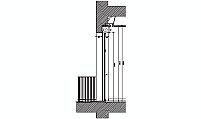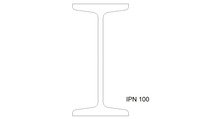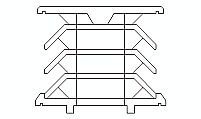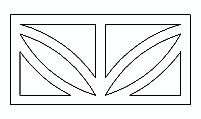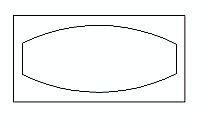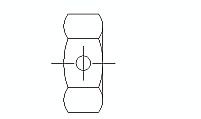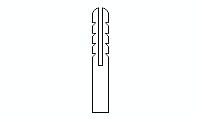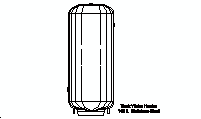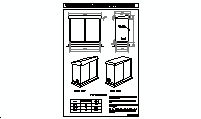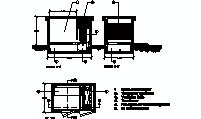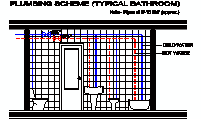CAD Blocks categories
 3D models
3D models home furniture
home furniture sanitary ware - bathrooms
sanitary ware - bathrooms professional equipment
professional equipment doors and windows
doors and windows people and animals
people and animals plants and trees
plants and trees vehicles - transports
vehicles - transports architectural details
architectural details mechanical - electrical
mechanical - electrical urban planning - civil works
urban planning - civil works safety health construction
safety health construction accessible design
accessible design drawing sheet
drawing sheet signals
signals construction machinery
construction machinery accessories and objects
accessories and objects maps and street maps
maps and street maps
Slim Wooden Baluster CAD Drawing

size: 6 kb
category: architectural details
related categories:
description: slim wooden baluster with an asymmetrical profile, showcasing a wider lower section and a slender top portion. Designed for decorative and structural purposes in balustrades.
file extension: .dwg CAD - AutoCAD software
Detailed Design and Applications of Slim Wooden Balusters
Design and Materials of Slim Wooden Balusters
The slim wooden baluster depicted in the drawing features an elegant, asymmetrical design where the lower portion is distinctly wider than the upper section. This unique shape ensures both aesthetic appeal and structural integrity, commonly used in staircases and balcony railings. The finely turned spindle transitions seamlessly between its elements, creating a graceful flow that adds to its decorative charm.
In addition to wood, slim balusters of this type are often crafted from granite, marble, or similar materials. These variations are chosen based on the project's style and durability requirements, offering options for both modern and traditional settings.
Dimensions of Slim Wooden Balusters
Typically, slim wooden balusters are designed with a height of 36 inches (91 cm) and a diameter of 1.5 inches (3.8 cm) at their narrowest section, gradually widening to 3 inches (7.6 cm) at the base. These measurements make them ideal for a variety of architectural applications, providing both safety and style.
The specific drawing provided shows a baluster with similar proportions, emphasizing its slender profile and slightly wider base for enhanced stability and aesthetic harmony in any design project.
Installation and Usage Tips
- How are slim wooden balusters installed?
- Slim wooden balusters are typically installed by fitting them into pre-drilled holes in both the handrail and the base rail. The installation process involves securing them with high-strength adhesive or screws, ensuring that they remain firmly in place. Careful alignment is crucial during installation to maintain uniform spacing and achieve a visually appealing result. For added stability, a combination of glue and mechanical fasteners is often used, especially in high-traffic areas such as staircases and balconies.
- Can they be painted or stained?
- Yes, slim wooden balusters can easily be painted or stained to match the aesthetic of the surrounding space. Before finishing, the surface should be sanded to remove any imperfections and ensure smooth application. Staining highlights the natural grain of the wood, while paint allows for creative color matching. Both options provide additional protection against wear and environmental factors, prolonging the life of the balusters and enhancing their overall appearance.
- What tools are needed for installation?
- The installation of slim wooden balusters typically requires a drill for creating or enhancing pre-drilled holes, screws or nails for securing the balusters, and wood glue for added adhesion. A level is essential to ensure proper alignment and prevent tilting during installation. Additional tools such as a measuring tape and clamps can help in achieving precision and stability, making the installation process smoother and more efficient.
- Are these balusters suitable for outdoor use?
- When properly treated, slim wooden balusters are well-suited for outdoor applications, including porches, decks, and gazebos. To withstand weather conditions, they should be sealed with a weather-resistant finish, such as exterior-grade paint or wood sealant. Regular maintenance, including resealing and cleaning, helps preserve their durability and aesthetic appeal, ensuring they remain a functional and decorative element of outdoor structures.
- Can they be used with modern designs?
- Absolutely. Slim wooden balusters are highly versatile and complement both traditional and modern architectural styles. In contemporary designs, they are often paired with minimalist handrails and base rails to create a sleek and elegant look. Their slim profile allows for creative combinations with materials such as glass, metal, or cables, resulting in unique and visually striking designs that enhance any space.
Advantages of Using Slim Wooden Balusters
Slim wooden balusters offer a timeless design that blends seamlessly into a wide range of architectural styles. Their lightweight yet sturdy construction makes them an excellent choice for both interior and exterior applications. Moreover, the smooth, turned finish elevates their aesthetic appeal.
Compared to heavier materials like stone or metal, wooden balusters are easier to handle and install. Their customizable nature allows for diverse finishes, ensuring compatibility with various design elements, from traditional staircases to minimalist railings.



